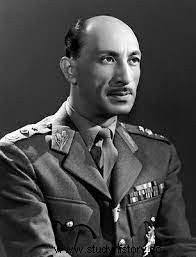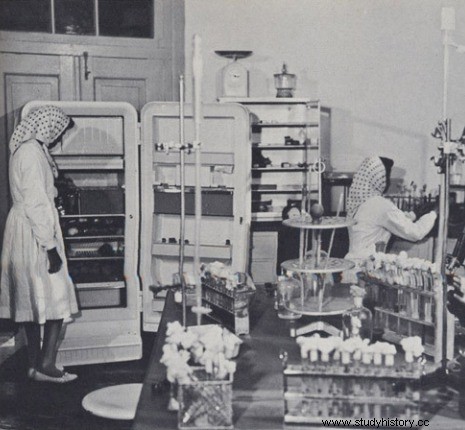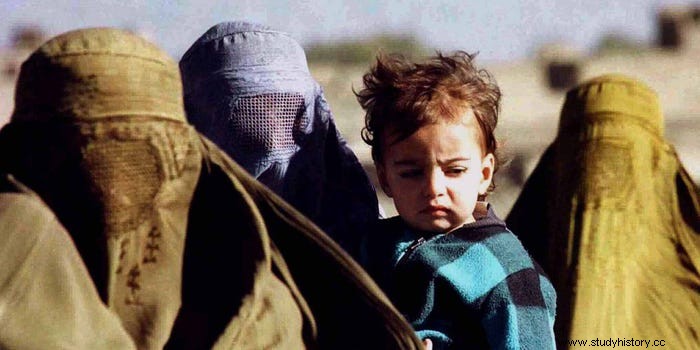The year is 1964. Traders wander around the base in Kabul and sell carpets and rugs, spices and refreshments of all kinds in a streamlined hut with cloth. The air smells like roasted chestnuts and sulaimani tea sharply against the scent of the first fresh snow, indicating the beginning of the winter break for students at Kabul University. Students - Men and women are dressed in the latest fashion they read about in the popular weekly magazine. A new lavender salwar and scarf with tiny mirrors glued, the latest type of denim skirt and matching sweaters. Everyone has access, with pearls and embroidery that compliment their personality. Groups of students sit and talk on the spot - probably about ambitions and future plans. This was Afghanistan almost 60 years ago. A tragic contrast to today's image of this beautiful country. The Afghans had a short time of westernization and stable internal development. Truly the golden age of Afghanistan, a sight to behold.

While Afghanistan is known for its rich traditional Islamic heritage, it was also the dream country from the 60s to the 70s. But the country has faced a relentless series of foreign invasions that began with Darius I around 500 BC, to Alexander the Great, to Mahmud of Ghazni (who is considered the greatest invader of Afghanistan), and this continues even today, far beyond the 21st century. This has created an irreversible dent not only in the country but also in the lives of the inhabitants. But how did a nation that reached such heights lose at a time when all the Oriental countries remained conservative in their homeland? How did the golden age of Afghanistan turn to darkness?
A short story about war, arguable peace and the golden age of Afghanistan
Amir Amanullah Khan (1919–1928)
Afghanistan has always been the subject of foreign conquests due to its favorable location on the Asian continent. The severity of these invasions worsened in the 19th century when the British tried to annex Afghanistan to protect the Indian Empire from Russia. This led to a series of British-Afghan wars (1838-42, 1878-80, 1919-21).
Fortunately for Afghanistan, Britain was besieged after World War I, thus ending the third and final British-Afghan war with Amir Amanullah Khan, the first king of Afghanistan in an independent country, by a ceasefire. He changed the title from E. Mir to P adshah , which meant that Afghanistan was officially a monarchy. Amir Amanullah Khan was concerned about the destructive state of the state and introduced socio-economic reforms for development. He introduced concepts of freedom and equality, which were revolutionary in that decade. He implemented constitutional and administrative changes, had women remove the veils and established co-educational schools. However, this angered the traditionalists and tribal leaders.

Habibullah Ghazi (1928–1929)
This sensational monarchical decade ended in 1928 with another invasion of Kabul by a Tajik folk hero Bacheh Saqqaw, who proclaimed himself Emir of Afghanistan Habibullah Ghazi; and Amir Amanullah Khan abdicated and fled to Italy after failing to revive the throne. However, the legacy of Amanullah returned and drove Habibullah away from the throne. An execution of 17 people and bloody persecution of the opposition later, Nadir Shah was elected king or shah by tribal leaders.
Nadir Shah (1929 - 1933)
Nadir Shah was a revolutionary for his age. He recaptured the monarchy and curated a constitution based on Amanullah's rule. As conservative as Nadir Shah was, he introduced the idea of capitalism to ordinary people. Under his brief rule in the 1930s, the national economy grew due to credit to the entrepreneurs who started small industries that were relevant to folk culture — such as spices and embroidered clothing. In another accident, Nadir Shah was assassinated in 1933. This led to the coronation of their last and last king, Mohammad Zahir Shah, heir to Nadir Shah.
Zahir Shah (1933 - 1973)

Zahir Shah, heir to Nadir Shah, ruled as monarch for 40 years. As king, he consolidated national policies, expanded foreign relations and internal development on Afghan funds alone, despite the losses suffered by World War II. The monarchy that was created flourished when Shah Mahmud, the prime minister, sanctioned free elections, allowed press autonomy and established a liberal parliament. However, Shah Mahmud lost power to Lieutenant General Mohammad Daud Khan, who later became Prime Minister. Daud Khan turned to the Soviets for economic and trade assistance and military assistance, but introduced far-reaching social and educational reforms. He allowed women to wear veils voluntarily instead of forcing and abolishing purdah - isolated women from the eyes of society and allowing women to have a public presence. He increased the workforce by almost twice by allowing women to receive comprehensive education and enter the workforce. His regime started Afghanistan's golden age.
After Daud Khan's resignation in 1963, Zahir Shah experimented with a constitutional monarchy in which he advocated a new constitution, in which the House of Commons should have 216 elected members and the House of Elders should have 84 members- all categorized into one-thirds elected by the king, the people and indirectly by new provincial assemblies. But this led to the rise of the conservative Islamists and the left-wing communists, and the purpose of a constitutional monarchy failed with the increasing polarization of national politics. This situation became clear with the appointment of the king by five successive prime ministers between September 1965 and December 1972. Zahir Shah also refused to publish important acts that contradict the guarantees notarized in the constitution.
Mohammad Daud Khan (1973-1978)
1973 witnessed the resurgence of Mohammad Daud Khan, who felt that the constitution stagnated and took power. He abolished the constitutional monarchy and proclaimed the Republic of Afghanistan, declaring himself the leader of the Central Committee of the Republic and, more importantly, the Prime Minister. He once again introduced a new constitution that moved away from socialist ideas and his regime supported in the beginning. Daud Khan undertook to merge and improve relations with other Muslim countries while trying to break its ties of dependence with the Soviet Union and the United States.
Nur Mohammad Taraki (1978 - 1979) - The Last Year of the Golden Age in Afghanistan
In 1978, Hafizullah Amin, an American-educated People's Party leader, contacted party members in the armed forces and drafted a temporary but successful coup. Their success can be attributed to the power of the military. Daud Khan and most of his family were killed, and the Democratic Republic of Afghanistan was born when Nur Mohammad Taraki took control of the country as president. They declared independence from the Soviet Union and declared policies influenced by Islamic principles, socio-economic justice and Afghan nationalism.
The Taraki regime announced affordable programs in which ocher was eliminated and equal rights for women were supported. However, Taraki signed a treaty of friendship with the Soviet Union. At the same time, conservative Islamic and ethnic leaders began protesting against social change that led to an armed uprising in the countryside. The guerrilla movement Mujahadeen was created to fight with the Soviet-approved government. Taraki's brief development lasted for a year before he was killed in a power struggle with Deputy Prime Minister Hafizullah Amin by his supporters. This was almost the end of the golden age in Afghanistan.
Hafizullah Amin (1979 - 1979) and Babrak Karmal (1979 - 1986)
That same year, the Soviet Union invaded Afghanistan to maintain the shaky communist regime and regain power over the country. Amin was executed that year. In the early 1980s, the Mujahadeen rebels united against Soviet invaders and the Afghan-backed Afghan army. This was a crucial moment when the lives of Afghans became uncertain as warfare witnessed about 2.8 million Afghans fleeing to Pakistan and another 1.5 million fleeing to Iran. Afghan guerrillas gained control of rural areas, and Soviet troops held urban areas. The remaining inhabitants of Afghanistan lost the little security and stability they had so far.
Mohammad Najibullah (1987 - 1992) and Mujahideen (1992-2002)

To make matters worse for the remaining people, Osama bin Laden made his first documented trip to Afghanistan to help anti-Soviet fighters in 1984, just as the UN was investigating human rights violations in Afghanistan. Their reports professed the Mujahideen was funded with military and economic assistance by Pakistan, the United States, China and several other European and Arab states.
In 1988, Osama bin Laden and 15 other Islamists formed the al-Qaeda group, or "base," to continue their jihad or holy war against the Soviets and others who opposed the goal of a pure nation ruled by Islam. The following year, 1989, the United States, Pakistan, the Soviet Union, and Afghanistan signed peace records guaranteeing another Afghan independence and the withdrawal of hundreds of thousands of Soviet troops. The Mujahideen now had room to fight the regime established by the Soviets and the Communist puppet president, Dr. Mohammad Najibullah. With increasing power, the Mujahideen and other Islamist rebel groups stormed Kabul and removed Najibullah from power. That year, in 1992, Afghanistan experienced a spasmodic turn in an already broken Afghanistan as the Mujahideen created a predominantly Islamic state and called the Islamic State Afghanistan.
Peace and stability became unrecognizable in Afghanistan. These rebel militias fought for influence, power and control over the people, which resulted in conflicts between ethnic groups, an inflated economy and desperate citizens who suffered continuous war, drought and famine and broken law and order.
Taliban rules (1995 - 2001)

In the next two to three years, a former Mujahadeen fighter, Mullah Mohammad Omar, recruited recruits, i.e. students from Pakistan Madrasas, and tried to take control of Afghanistan. The Islamic State of Afghanistan became the Islamic Emirate in Afghanistan with the entry of the Taliban. Their eventual success is traced to the people who were inevitably tired of wars and promises by the Taliban to end internal violence and promote peace, amicability and tradition, which contrasted with the decades of unstable Afghan rulers who seemed like a viable hope. In 1995, the Taliban captured the heart of the country, Kabul, and gradually expanded its power to over nine tenths of the country.
The Taliban failed to keep their promise of peace, and in the name of upholding traditional values, they imposed a brutal scheme. This decade was the darkest period for the Afghans, as they helplessly witnessed horrific crimes, feared for their lives at every step and saw their loved ones executed and amputated in public. The retaliation for receiving the Taliban took place on women. They lost all the basic freedom and liberty they had so far.
In the days before the Taliban, women had access to professional careers, university education, freedom to wear non-traditional clothing, public appearance without a male escort, and also the right to vote. The country had to fall back from already slow progress to become a democracy. Under the Taliban government, women were subjected to public humiliation under the circumstances in which these laws were violated, by being whipped from the Taliban or publicly executed. At that time, more than a million Afghans fled to neighboring countries to escape persecution.
Intolerance of cultures other than Islam was promoted and practiced. Buddhist statues in Bamiyan were destroyed as an insult to Islam. International aid workers were brought to justice during allegations of spreading Christianity. The golden age in Afghanistan was long dead in the early 2000s.
According to a 2001 State Department report from the Bureau of Democracy, Human Rights and Labor:
Before the rise of the Taliban, women in Afghanistan were protected by law and increasingly given rights in Afghan society. Women gained the right to vote in the 1920s, and as early as the 1960s, the Afghan constitution ensured equality for women. There was a mood of tolerance and openness when the country began to move towards democracy. Women made important contributions to national development. In 1977, women made up over 15% of Afghanistan's highest legislative body. It is estimated that in the early 1990s, 70% of teachers, 50% of government workers and university students and 40% of doctors in Kabul were women. Afghan women had been active in humanitarian aid organizations until the Taliban imposed severe restrictions on their ability to work. These professional women provide a pool of talent and expertise that will be needed in the reconstruction of Afghanistan after the Taliban.


Post-Taliban rules (2001-2021)
Jumping in after the 9/11 attacks and airstrikes in Afghanistan, the Taliban announced that they were ready for Jihad, which started a war with the Northern Alliance. After weeks of intense warfare, the Taliban surrendered the last Afghan territory, the province of Zabul and Islamic Press officially declared the end of the Taliban regime in 2001, and Hamid Karzai, a royalist and ethnic Pashtun, was sworn in as head of interim government in Afghanistan and a new constitution was adopted.
This constitution brought back a structured political system, gender equality and parliamentary elections. With US sanctions and support, Afghanistan held its first election in 30 years. Afghans enjoyed just over 20 years of relative freedom until August 2021, when US President Joe Biden withdrew US troops from Afghanistan and the government collapsed, again, into the hands of the Taliban.
To conclude
Afghanistan has been on a tough journey since it was declared an independent country. The moments of peace and normalcy, especially for the women, were short and fluctuating. Afghanistan's golden age is long gone, and the people no longer feel safe and secure in their homeland. The 70s picture and today's picture are polar opposites. There was a time when kite flying was festively celebrated and a time when children ran on the streets without any problems. Weapons and loops are now a common sight, hunger and distress are widespread, and fear and helplessness are raging emotions. Afghanistan, in the hands of the Taliban today, has no spark of hope or ambition. With people trying to flee every day, no one can predict the coming weather in Afghanistan.
For more information, https://www.britica.com/place/Afghanistan and https://www.hrw.org/asia/afghanistan are useful resources.
